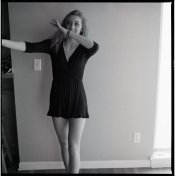Well said Tom. I'm honored to have held some of your Caffenol prints and talk over your milestones in your process.
Ming Rider - If again you get a good result in round 2, I've still some HP5+ and Rodinal that Id be happy to run one roll thru your new "recipe"....just post your notes and whatnot. I've been burning up a lot of HP5+ and Rodinal/HC110/Diafine this summer in one of my plastic cameras, I don't mind tossin a roll towards your theory to help your pursuits. I like that you've a Leica and I a plastic P&S, seems we've the whole spectrum there
If this "salt bath" is a dead end so what, you've tried and shared with a comminity your work, which is a key virtue to happiness
Don't let the dissenters get ya down. So what if the salt Rodinal stand techniquue is a bit Rube Goldberg....we are all talking and that's gotta count for something. I'm enjoying this thread and I am one of those folks who does't like stand, it's never worked for me....though I respect your theory, flawed or not....lets see where the cards fall! We've got a lotta folks suggesting better test design models with ideas. Hope you bake in some of that, Michael, Ian, Poly. Etc. Nowhere but up! Let round 2 begin!
Ming Rider - If again you get a good result in round 2, I've still some HP5+ and Rodinal that Id be happy to run one roll thru your new "recipe"....just post your notes and whatnot. I've been burning up a lot of HP5+ and Rodinal/HC110/Diafine this summer in one of my plastic cameras, I don't mind tossin a roll towards your theory to help your pursuits. I like that you've a Leica and I a plastic P&S, seems we've the whole spectrum there

If this "salt bath" is a dead end so what, you've tried and shared with a comminity your work, which is a key virtue to happiness

Don't let the dissenters get ya down. So what if the salt Rodinal stand techniquue is a bit Rube Goldberg....we are all talking and that's gotta count for something. I'm enjoying this thread and I am one of those folks who does't like stand, it's never worked for me....though I respect your theory, flawed or not....lets see where the cards fall! We've got a lotta folks suggesting better test design models with ideas. Hope you bake in some of that, Michael, Ian, Poly. Etc. Nowhere but up! Let round 2 begin!





